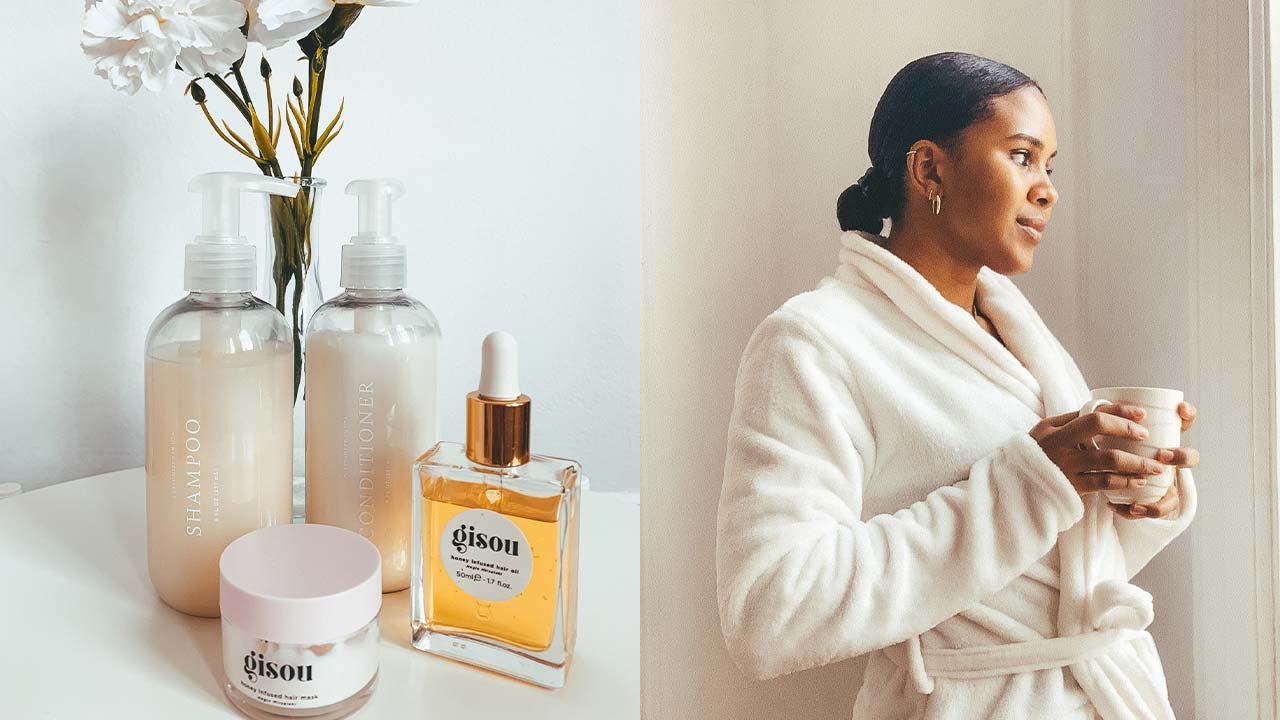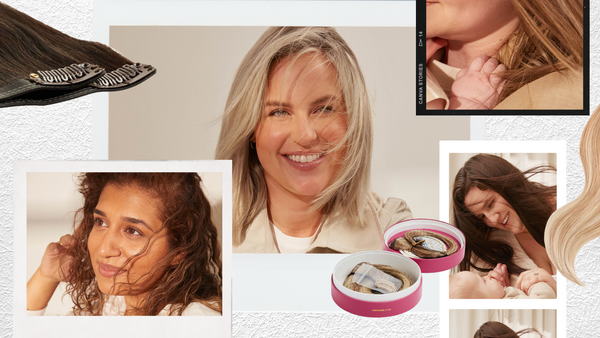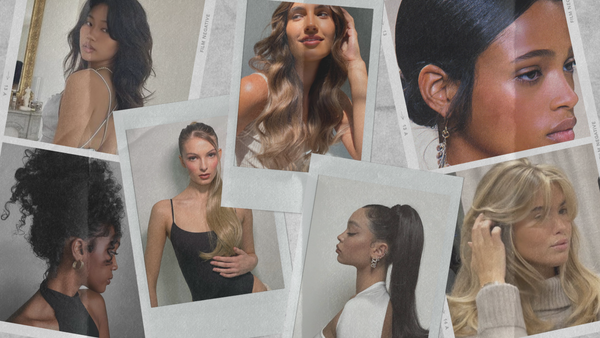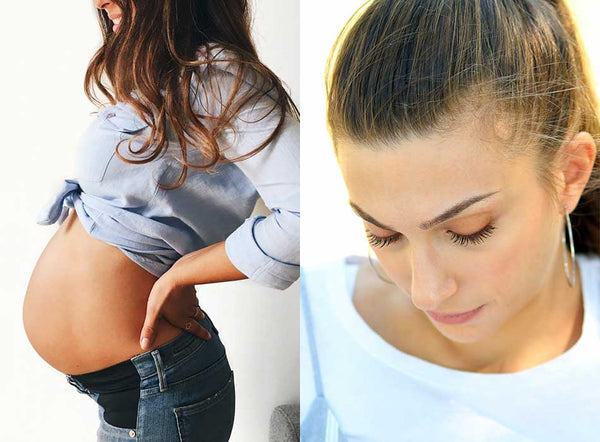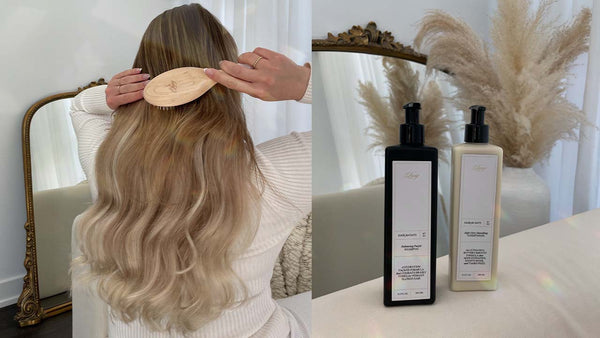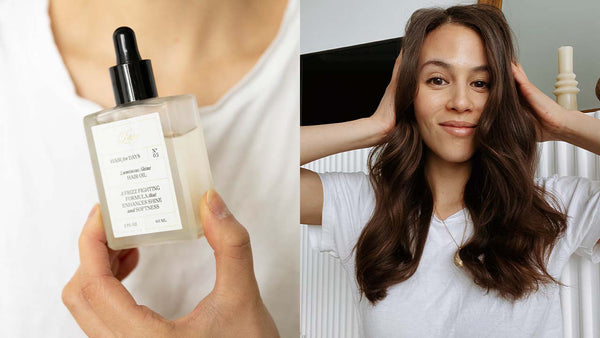If you’re conditioning and moisturizing, but your hair still gets dry and frizzy, it may be time to do a hair porosity test.
Porosity is your hair’s ability to retain and absorb moisture. Like your hair type, genetics mostly determine your hair porosity, but other factors such as chemical treatments, the weather, and heat styling can also impact hair porosity.
It’s important to know your hair porosity to help you choose the best products and ingredients to help treat and maintain your hair health and hair needs. Knowing your hair porosity will also help you better understand how to style your hair and what techniques to use (i.e. heat styling doesn’t work for all hair porosity types). Knowing your hair porosity may not be as talked about as knowing your hair type, but it’s just as important if you want to maintain healthy, strong hair.

What are the different types of hair porosity?
There are three types of hair porosity: low, normal, and high.
Low porosity hair means the cuticle lays flat on the outside blocking water or moisture from being absorbed into the strands. You can easily tell you have low porosity, if your hair takes longer to dry or products seem to build up into the hair instead of blending in. Low porosity hair is not necessarily unhealthy, it just isn’t being moisturized correctly.
Normal porosity hair has cuticles that are looser which allows moisture to penetrate the strands more easily.
High porosity means there may be tears or damage around the cuticle which can be caused by chemical hair treatments or heat styling, among other factors. It also means the hair can easily and quickly soak up product, meaning you usually need to apply more to see its effects. Even with highly porous hair, it may absorb product quickly, but it doesn’t necessarily mean it is hydrated or properly nourished.

How to do a hair porosity test
Determining your hair porosity will inform your product decisions and hair care routine so your hair gets the moisture it needs. While hair porosity is important for all hair types, curly and wavy hair girls should especially be aware of their porosity type as curly hair tends to dry out more easily. Curly hair has a natural tendency for dryness because the natural oils your scalp produces can travel down the strand of straight hair much easier than a curly one. So even with healthy and normal porous hair, moisture is always essential.
The hair porosity test or float test is super simple, all you need is a clear glass of water and a couple strands of your hair. It’s best to do this when your hair is dry and product-free. Brush your hair and take the strands that have shed and put them in your clear glass or bowl of water.

If your strands sink to the bottom it has high porosity and is absorbing all the moisture. If your strand remains under the surface but floats above the bottom of the bowl, your hair is well-balanced and is of normal porosity. If the strand of hair floats above the surface of the water your hair has low porosity and does not absorb moisture easily.
Another option is the strand test. This works especially well if you have curly hair. To do the strand test, gently stretch a tiny section of curl strands from different areas of your head – front hairline, crown or temple. Place the stretched curl between your thumb and finger and slide it up the hair strand from the tip towards your scalp. If your fingers move easily up the strand and it feels dense and hard, you have low porosity hair. If it feels smooth, you have normal porosity hair. If the strand feels rough, dry, or it breaks, you have high porosity hair.

For low porosity hair avoid heavy, thick products and single ingredient thicker oils. While you want to retain moisture, you also want to avoid build-up.
For low porosity hair, the key is to help strands retain moisture. This starts with your wash routine. Minimize shampoo and conditioning to 1-2 times a week. Before stepping into the shower or washing the hair use an oil first that can penetrate strands and help moisture lock in before cleansing.
To get the most out of products, try applying them while the hair is damp and ensure products are evenly distributed to prevent build-up.
Jojoba oil is a great option for low porosity hair because it helps to lock in moisture and also helps to create shine and promote growth. This jojoba oil comes in three different sizes.

Avocado oil also helps low porosity hair when pre-shampooing. Apply avocado oil before your wash routine or use as a mask once a week. NaturAll Nourishing Avocado Leave-In is a product to try.
People with low porosity hair may find they may need more than one chemical treatment when coloring, straightening, or curling their hair, but repeating several chemical treatments can be heavily damaging. Make sure to use products for color-treated hair and moisturizing treatments to help lock the style in, but also maintain the health of your hair.

How to care for normal porosity hair
Lucky you! Normal porosity hair requires less maintenance, however there are steps to take to ensure your hair stays in the “normal” healthy range. Deep conditioning and detox masks once a week or once every two weeks depending on your hair type would certainly help your hair maintain its strong ability to absorb and retain moisture along with preventing any product build-up. African Pride Moisture Miracle Coconut Oil & Baobab Oil Leave-In Hair Cream is a great 2-in-1 product that helps to detox and moisturize your medium or normal porous hair.
Hair masks also don’t have to come off the shelf from your drug or beauty store. We’ve put together 7 DIY hair masks that are great for medium porous hair.

For high porosity hair it’s best to avoid sulfates, parabens, silicones, and sodium laureth sulfates. These ingredients can pull natural oils from your hair which it needs for strength and growth.
With highly porous hair, it’s common to experience dryness, shedding and hair that breaks easily. The cuticle around the hair strand is damaged, so while moisture will penetrate it will not be retained, drying out the strands. For highly porous hair, it’s best to avoid heat styling and treatments high in chemicals that can continue to dry out the hair. If you often use color treatments or relaxer treatments for curly and coily hair, these processes break down and damage your cuticles leading to highly porous hair. To help treat high porosity hair, look to hair masks, oils, and products that will provide moisture and help repair the damaged cuticles.
Coconut oil is great for people with high porosity hair as it blocks the cuticles and prevents water from flooding into the strands too quickly, helping your strands to retain moisture. This SheaMoisture 100% Virgin Coconut Oil Leave-in Conditioner Treatment is great as a mask or as a pre-shampoo and conditioner treatment.
Hair care tips of all hair porosities
Whether you have low, normal or high porosity hair, there are a few universal hair care rules to follow for all hair types. It’s also important to note, the seasons may also impact your hair. Exposure to UV can dry out the hair and scalp impacting porosity, as well as cold, dry weather. You may need to adjust your hair routine according to the seasons, but otherwise maintaining your hair’s moisture is essential for good hair health all year-round.
- Minimize heat styling and use a heat protectant before blow-drying, curling or straightening.
- Limit chemical treatments like coloring and relaxing when possible. Schedule these appointments two to three times a year at a maximum if possible and be sure to be extra vigilant with the hair care advice according to your hair porosity to keep chemically treated hair healthy. For more tips on how to treat colored hair, check out these tips. For hair care advice and information about chemically relaxing your hair, check out this article.
- Use a hair oil as a leave-in treatment before you shampoo (here are 5 popular hair oils, and how they help)
- Use a non-sulfate shampoo (we recommend Briogeo Don’t Despair, Repair Super Moisture Shampoo)
- Use a deep conditioner that contains protein and moisturizing ingredients (we recommend Mielle Organics Babassu Oil And Mint Deep Conditioner)
- Use a water-based moisturizer after your wash routine (we recommend Moroccanoil Hydrating Styling Cream)

Hair extensions and hair porosity
Whether for low or highly porous hair, hair extensions are a chemical-free way to experiment not just with color, but with different textures, lengths, and styles. Luxy Hair’s Balayage and Ombre Extensions are clipped-in and are the fastest, easiest, and safest way to play with color with your natural look while also adding length and fullness in just minutes. Hair extensions can be styled before applying which not only saves your natural hair from heat but makes getting ready easier and faster. The best part about hair extensions is being able to experiment without the damage for a refreshed look and sun-kissed dimension, or try out new hair trends like reverse balayage.
Hair porosity is just one category that helps to fully determine your hair type. Density, elasticity and texture all play a part and are important to understand your unique hair needs. It isn’t enough to keep using the same products and same process year after year. The hair porosity test is an easy one to do to “check in” with your hair health. Understanding the type of hair you have and your hair porosity means putting time and money into products and treatments that will actually work for your hair and help your hair to absorb and retain the moisture it needs for healthy, strong and shiny hair.
Written by: Rosalyn Solomon
